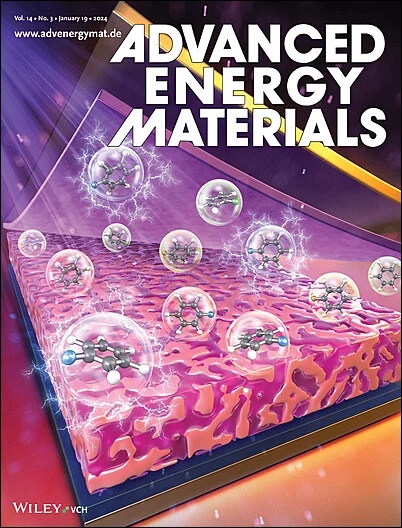用于高性能全固态锂电池的Li2O -增强固体电解质界面,超越仅限锂离子的SEI
IF 26
1区 材料科学
Q1 CHEMISTRY, PHYSICAL
引用次数: 0
摘要
固态锂电池在实现稳定的电极-电解质界面方面面临着严峻的挑战,其中固体电解质界面(SEI)的形成特征和结构特性对电池性能具有关键影响。虽然富锂SEI层因其增强界面稳定性的能力而被广泛研究,但li20的贡献-提高离子电导率和机械稳健性的关键成分-在很大程度上被忽视了。本研究通过开发醋酸纤维素(CA)修饰的电解质体系解决了这一缺陷,该体系促进了SEI层内LiF和Li2O的协同生成。因此,CA修饰的聚环氧乙烷(PEO)基电解质具有优异的电化学稳定性,确保在高压(达到4.3 V)和宽温度范围(- 10°C - 60°C)下的可靠性能。这种改善归因于协同的LiF - Li2O复合SEI层,它增强了界面离子传输和机械稳定性。此外,该方法的可扩展性在实际的袋状电池中得到了证明,在0.1 C下,在300次循环中保持了132 mAh g−1的放电容量,平均库仑效率为99.79%。这项工作强调了Li2O在补充以LiF为主的SEI层中的关键作用,为推进高效全固态储能系统提供了一条有希望的途径。本文章由计算机程序翻译,如有差异,请以英文原文为准。
Li2O‐Enhanced Solid Electrolyte Interphase Surpassing LiF‐Only SEI for High‐Performance All‐Solid‐State Li Batteries
Solid‐state lithium batteries face critical challenges in achieving stable electrode‐electrolyte interfaces, where the formation characteristics and architectural properties of the solid electrolyte interphase (SEI) critically influence battery performance. While LiF‐rich SEI layers have been widely studied for their ability to enhance interfacial stability, the contribution of Li2 O—a key component in improving ionic conductivity and mechanical robustness—has been largely overlooked. This work tackles this deficiency by developing a cellulose acetate (CA)‐modified electrolyte system, which facilitates the cooperative generation of LiF and Li2 O within the SEI layer. Consequently, the CA‐modified poly(ethylene oxide) (PEO)‐based electrolyte enabled exceptional electrochemical stability, ensuring reliable performance under elevated voltages (reaching 4.3 V) and across a wide temperature range (−10 °C–60 °C). Such improvements are ascribed to the synergistic LiF‐Li2 O composite SEI layer, which enhances interfacial ion transport and mechanical stability. Furthermore, the scalability of this approach was demonstrated in practical pouch cells, which maintained a discharge capacity of 132 mAh g−1 over 300 cycles at 0.1 C, exhibiting an average Coulombic efficiency of 99.79%. This work highlights the critical role of Li2 O in complementing LiF‐dominated SEI layers, offering a promising pathway toward the advancement of high‐efficiency all‐solid‐state energy storage systems.
求助全文
通过发布文献求助,成功后即可免费获取论文全文。
去求助
来源期刊

Advanced Energy Materials
CHEMISTRY, PHYSICAL-ENERGY & FUELS
CiteScore
41.90
自引率
4.00%
发文量
889
审稿时长
1.4 months
期刊介绍:
Established in 2011, Advanced Energy Materials is an international, interdisciplinary, English-language journal that focuses on materials used in energy harvesting, conversion, and storage. It is regarded as a top-quality journal alongside Advanced Materials, Advanced Functional Materials, and Small.
With a 2022 Impact Factor of 27.8, Advanced Energy Materials is considered a prime source for the best energy-related research. The journal covers a wide range of topics in energy-related research, including organic and inorganic photovoltaics, batteries and supercapacitors, fuel cells, hydrogen generation and storage, thermoelectrics, water splitting and photocatalysis, solar fuels and thermosolar power, magnetocalorics, and piezoelectronics.
The readership of Advanced Energy Materials includes materials scientists, chemists, physicists, and engineers in both academia and industry. The journal is indexed in various databases and collections, such as Advanced Technologies & Aerospace Database, FIZ Karlsruhe, INSPEC (IET), Science Citation Index Expanded, Technology Collection, and Web of Science, among others.
 求助内容:
求助内容: 应助结果提醒方式:
应助结果提醒方式:


